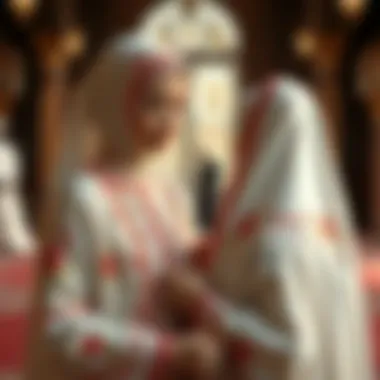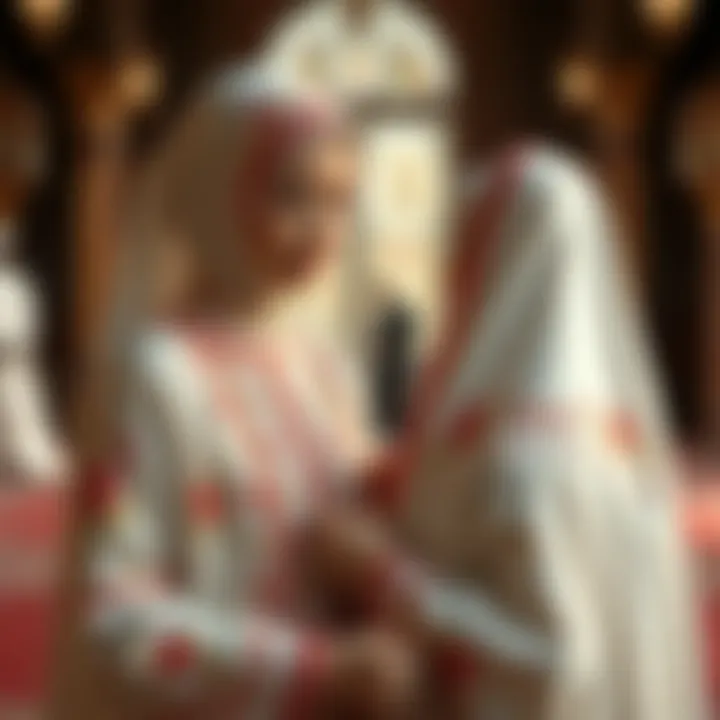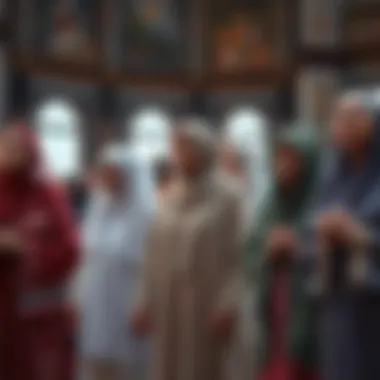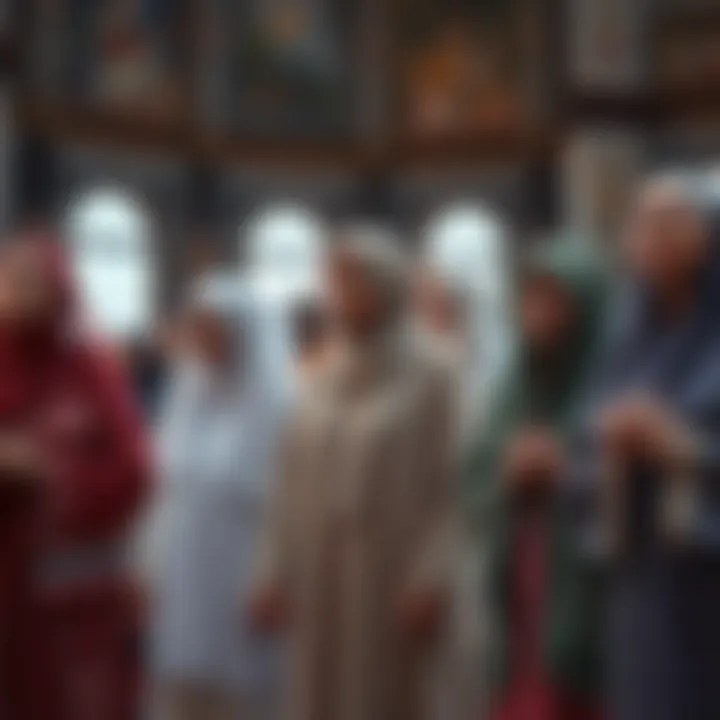Prayer Clothes for Women: Cultural Significance and Style


Intro
Prayer clothing for women carries substantial cultural and spiritual weight. Beyond mere fabric, these garments reflect individual faith, societal norms, and personal identities. Across different contexts, prayer clothes serve not only as expressions of devotion but also as creative outlets where traditional meets contemporary. Understanding these garments necessitates an exploration of their significance, design variations, and the shifting fashion landscape that envelops them.
This discussion starts with a close look at current trends in prayer attire, unveiling how they evolve with the seasons. Additionally, we delve into iconic styles that have made significant waves throughout various decades, illustrating how history shapes today’s choices.
Moving forward, we will provide styling tips and techniques to promote versatility in personal wardrobes. Layering is an essential skill for achieving effortless looks that maintain both modesty and style.
Through this examination, we aim to unravel the threads of tradition and modernity, enabling designers, stylists, and fashion-forward individuals to appreciate, create, and innovate in the realm of prayer clothing for women. Let’s dive headfirst into the analysis of clothing trends that encapsulate this fascinating intersection of faith and fashion.
Preface to Prayer Clothes
In today's ever-evolving world, the idea of prayer clothes holds deep significance for many women across various faiths and cultures. Understanding prayer clothes is not merely about fashion or attire; it encapsulates the convergence of tradition, spirituality, and identity. An exploration of this topic reveals nuances that go beyond fabric and design.
Traditional garments worn during prayer serve as both a bridge to spiritual practice and a canvas for personal expression. It is crucial to delve into their significance, as they offer insights into the lifestyles and belief systems that shape the communities embracing these garments. Take, for instance, the graceful abayas worn in the Middle East or the intricate saris during Hindu ceremonies; each piece tells a story, representing centuries of cultural evolution.
When we talk about the importance of prayer clothes, we should consider their role in empowering women. These garments allow women to display their faith and personal style, balancing modesty with individuality. The act of adorning oneself in a prayer outfit can create a focused mindset, setting the atmosphere for reflection and connection during moments of worship.
The best part? Exploring these garments uncovers the fabric of cultural identity interwoven throughout societies. By understanding the elements involved, one begins to appreciate how prayer clothes can signify belonging, community ties, and personal beliefs.
Defining Prayer Clothes
When we define prayer clothes, we must recognize that they are not limited to just one style or cut. They encompass a wide variety of garments that can be seen in different religious practices, locations, and cultural contexts. Though they might differ from one faith to another, the common thread lies in their primary purpose: these are the clothes that help individuals engage in spiritual practices with reverence and a sense of devotion.
For example, in Islam, many women choose to wear hijabs or abayas during Salah, the Islamic prayer. In contrast, Christian women may choose to wear modest dresses or head coverings when attending church services. The clothing serves to create an atmosphere of respect and sanctity while also allowing the individual to feel comfortable and authentic.
Thus, prayer clothes are embedded with layers of meaning, tradition, and intent, revealing much about the society and beliefs from which they emerge. Understanding this spectrum helps to better appreciate the rich diversity in prayer attire.
Historical Overview
Examining the history of prayer clothes offers a fascinating backdrop that reflects shifts in cultural norms, societal expectations, and religious interpretations. From ancient rituals to modern practices, garments have evolved dramatically.
- Environments like ancient Egypt saw the use of linen tunics during religious ceremonies. These garments were not merely practical; they also held symbolic relevance, emphasizing purity and devotion.
- In the Mediterranean, early Christians adopted modest dress as a means of expressing their piety. Over time, the styles transformed, yet the core message remained—these clothes were a vehicle for one's commitment to faith.
- With the advent of globalization and modern fashion influences, the traditional designs faced new challenges. Many women adapted their prayer garments to align with contemporary styles while still holding onto cultural heritage.
"Clothing serves as a critical factor in defining spirituality, not just as a physical representation but also a source of identity and belief."
In a nutshell, the historical context reveals how prayer clothes have persisted and adapted through ages, making them a powerful commentary on the intersection of faith, identity, and everyday life.
Cultural Significance
The cultural significance of prayer clothes for women is vast and layered, reflecting personal belief systems, communal identities, and the role of tradition in contemporary society. These garments do not merely serve as clothing; they act as a bridge connecting women to their faith while illustrating how cultural narratives shape personal expression.
Understanding this aspect is crucial because it speaks to the profound relationship between identity and attire. The prayer attire selected often speaks volumes about where a person comes from and the values they hold dear. Additionally, these clothes act as elements of social cohesion, fostering a sense of belonging within religious communities. In an age where individualism is often celebrated, prayer clothes assert the importance of collective traditions that shape various faith identities.
"Clothing is a statement of culture; it reflects what we believe, who we are, and how we engage with the world around us."
Prayer Attire in Various Faiths
In many religious traditions, prayer attire is not just a matter of personal choice; it is often dictated by religious commandments or cultural practices. For example, in Islam, many women wear hijabs or abayas during prayer. These garments symbolize modesty and devotion. The act of donning these clothes transforms a daily task into a sacred ritual, setting a tone of reverence and focus.
Conversely, in Christian faith, prayer attire varies widely. Some women may choose to wear simple dresses or head coverings during services, reflecting their commitment to modesty. In some Pentecostal communities, for instance, women wearing long skirts is a visible manifestation of their belief in biblical principles regarding femininity and worship.
Some Jewish women opt for modest clothing as a sign of respect when praying. The concept of covering one’s head, using a headscarf or hats, illustrates both reverence and identity. As we can see, each faith imbues clothing with specific meanings that extend beyond mere fabric.
Symbolism of Prayer Clothes
The symbolism associated with prayer clothes is intricate and often intertwined with the wearer’s personal narrative and communal beliefs. Many prayer garments carry colors, designs, and fabrics that have significant religious meanings.
- Colors: In Hinduism, for example, saffron is seen as a symbol of purity and spirituality, often worn for prayers and ceremonies.
- Patterns: Some Native American tribes incorporate symbols and patterns into their prayer clothing that signify their connection to ancestral spirits and cultural heritage.
- Fabrics: The choice of fabric can also express sentiments; silk might signify wealth and spirituality, while cotton is often associated with simplicity and humility.
Moreover, these garments can represent personal journeys and collective memory. When women wear these prayer clothes, they symbolize their faith while also embodying the struggles and triumphs of their communities. Ultimately, prayer clothes are not taught merely to adorn the body; they serve as powerful declarations of belief and identity in every facet of life.
By closely examining the cultural significance of prayer clothing, we understand that these garments are deeply meaningful. They encapsulate faith, identity, and community—elements that define the experience of women across diverse traditions.
Design Elements of Prayer Clothes
When we think of prayer clothes, it's crucial to recognize their profound role beyond mere fabric. These garments serve not only as a means of modesty but also as a canvas for cultural expression, spirituality, and personal style. Each component within the design is purpose-driven, intricately connected to the wearer's identity and the traditions they represent. The design elements—cut and style, color psychology, and material choices—are essential in making prayer clothes functional yet reflective of individual beliefs and backgrounds.


Cut and Style
The cut and style of prayer clothes vary significantly across cultures and religions, each reflecting unique traditions and interpretations of modesty. For example, in Islamic fashion, the abaya, a flowing gown, allows for comfort and ease of movement, while the kaftan offers a blend of elegance and simplicity. The style choices are not merely aesthetic; they often have practical implications. Women need to feel unrestricted during their prayers, allowing for deep focus and connection during spiritual moments.
Different regions influence these designs as well. The silhouette of the traditional Ethiopian habesha kemis, characterized by its body-skimming cut and vibrant borders, symbolizes grace and heritage. Similarly, the Indian salwar kameez combines functionality with culture, making it a popular choice for various prayer contexts among women in South Asia. Understanding these elements helps designers create pieces that honor tradition while catering to modern sensibilities.
Color Psychology
Color plays a pivotal role in the design of prayer clothes, deeply intertwined with emotions and meanings. Each hue can evoke specific feelings or symbolize particular beliefs. For instance, white often represents purity in many religions, making it a popular choice for prayer attire. In contrast, vibrant colors like deep blues or rich reds may carry meanings of vitality, spirituality, or even an invitation to higher consciousness.
Moreover, understanding color psychology can assist designers in crafting garments that resonate on a deeper emotional level with wearers. Women might opt for lighter shades during peaceful moments of prayer but decide on lively hues for community gatherings or celebrations. This emphasis on color can create a sense of belonging and identity, reinforcing the spiritual experience and personal expression through fashion.
Material Choices
The materials used in prayer clothing are a defining factor in comfort, durability, and appropriateness. Natural fibers like cotton and linen allow breathability, ideal for those long hours of prayer in warmer climates. Meanwhile, fabrics like silk or high-quality polyester can bring an element of luxury to prayer wear, suitable for special occasions or gatherings. Understanding the context and the climate is essential when selecting materials.
In recent times, the trend toward sustainability has reshaped material choices within the fashion industry, including prayer clothing. Designers are now leaning into organic fabrics or recycled materials, allowing spirituality and ethics to coexist harmoniously. These thoughtful choices resonate well with modern consumers who seek not just aesthetic beauty in their prayer attire, but also an alignment with their values and beliefs.
"The right design elements in prayer clothes can enhance not just the spiritual experience but also celebrate individual expression amidst tradition."
By thoughtfully engaging with these design elements—cut and style, color psychology, and material choices—designers can create prayer clothes that are not only beautiful but deeply resonant with the wearer's spirituality and identity.
Functional Aspects of Prayer Clothes
In the world of prayer clothes, function goes hand-in-hand with tradition and style. These garments are not just about aesthetics; they serve essential roles in comfort, mobility, and practicality in various contexts of spiritual practice. Understanding these functional aspects sheds light on why certain styles or materials are prevalent among different cultures and can greatly influence a woman’s experience during prayer.
Comfort and Mobility
First and foremost, comfort is key. Women engage in prayer with a sense of humility and devotion, often spending extended periods in various positions, from standing to kneeling to sitting. Therefore, the choice of attire plays a significant role in facilitating this experience.
Prayer clothes, such as loose-fitting tunics or flowing dresses, allow for ease of movement while ensuring modesty. For instance, a flowing abaya not only provides coverage but also allows for unrestricted arm movement during rituals. Being able to move freely contributes to a woman's ability to focus on her spiritual connection without the distraction of tight or ill-fitting garments.
The materials chosen for these garments also have a profound impact on comfort. Natural fibers, like cotton or linen, breathe better, helping to regulate body temperature, especially during prolonged prayer sessions or in warmer climates. Thus, selecting clothing crafted from lightweight, durable, and breathable materials is crucial to both comfort and functionality.
Another consideration is the size and silhouette of the clothing. For example, prayer shawls should ideally be generous in cut, ensuring that a woman can wrap herself comfortably without feeling constricted. Also, the length of the garment matters; longer garments may be preferred in settings where a woman wants to maintain traditional modesty standards, while shorter styles may be acceptable in more contemporary settings.
Seasonal Considerations
Seasonality introduces another layer of complexity when it comes to prayer clothes. Women must think about temperature fluctuations and weather conditions that can influence their choice of attire for prayer.
During summer months, lighter fabrics are preferred to combat heat. Garments made from breathable materials that allow ventilation are ideal. A linen hijab, for instance, can be both stylish and practical, providing sun protection while maintaining comfort.
Conversely, in winter, the need for warmth takes precedence. Layering becomes essential. Many women choose to wear thermal undergarments beneath their prayer clothes or opt for heavier fabrics, such as wool blends, to retain warmth during cold prayer gatherings, especially in outdoor settings. Additionally, accessories like shawls and scarves become functional yet fashionable additions to winter prayer attire. These layers not only add warmth but also, when styled correctly, can enhance the overall aesthetic of the outfit.
Understanding the interplay between climate and the materials used leads to more mindful choices in prayer garments, enhancing the experience and ensuring that one can remain focused on what truly matters: the act of prayer itself.
As one navigates the various options available for prayer attire, it's vital to assess not only the style and cultural significance but also how these garments will function in real-life settings. The right choice can enhance spiritual practices by allowing for greater comfort, ease of movement, and adaptability to the seasons, ultimately fostering a deeper connection to one's faith.
"The blend of style and function in prayer clothes serves not only to honor tradition but to promote a seamless, enriching prayer experience."
For further reading on cultural attire relating to prayer, you may refer to Wikipedia on Cultural Clothing or consult resources on related studies from reputable educational institutions.
Trends in Prayer Clothing
The trends surrounding prayer clothing are as diverse as the women who wear them. This section seeks to shed light on how these trends not only influence the aesthetic of prayer attire but also reflect broader societal shifts. From a resurgence in traditional styles to contemporary innovations, understanding these trends is crucial. They demonstrate the intersection of faith, identity, and fashion. Furthermore, observing these shifts can help designers, stylists, and fashion students anticipate future developments in the realm of prayer wear.
Contemporary Styles
In recent years, there has been a notable revival of classic pieces alongside fresh interpretations of prayer attire. Women are increasingly drawn to contemporary styles that incorporate modern design elements while still respecting traditional significance. For example, flowing kaftans and long tunics have made a significant comeback, but with updated patterns and textile choices.
- Asymmetrical Cuts: One trend carving a niche is the use of asymmetrical cuts. This design element encourages movement and comfort while still providing a modest silhouette.
- Layering: Mixing layers with various textures and colors can create a visually appealing and functional outfit. Lightweight cardigans over a simple prayer dress are becoming quite popular.
- Minimalist Aesthetics: In a world swamped with noise, many seek simplicity. Neutral tones, clean lines, and unembellished fabrics create a sense of calm and focus, especially for spiritual practices.
Modern prayer clothes have also begun to integrate spiritual motifs, such as subtle embroidery or prints that have personal meanings. This reflects an evolving desire to connect one’s personal identity with their faith without compromising style.
Sustainable Practices in Production
With the rise of global awareness about sustainability, the production of prayer clothes is also adapting. There is a keen focus on ethical sourcing and eco-friendly materials. Here, we can observe several key practices making waves in the fashion world.


- Organic Fibers: Increasingly, designers are opting for organic cotton, linen, and bamboo. These materials not only reduce carbon footprints but also offer comfort and breathability, essential for prayer garments.
- Techniques Reducing Waste: Brands are exploring zero-waste pattern making. By maximizing fabric usage, they not only minimize waste but also create unique pieces that stand out in a sea of mass-produced items.
- Support for Artisan Crafts: Collaborations with local artisans to produce prayer dresses can lead to beautifully crafted pieces while supporting traditional crafts. Not only does this create jobs, but it also enables the revival of cultural heritage through apparel.
These sustainable practices are gaining traction as more women prioritize environmental concerns alongside their spiritual attire. Buyers have become more conscious of the journey their clothing has taken, prompting many to seek out pieces that tell a story.
Influences of Modern Fashion
The relationship between prayer clothing and mainstream fashion continues to evolve, creating a beautiful interplay of influences. Designers today often draw from high fashion, adapting runway trends to fit the unique requirements of prayer wear.
- Street Style Adaptations: The casual street style movement has led to an influx of a more relaxed approach to prayer attire. Women can be observed pairing prayer garments with trendy sneakers and statement accessories, perfectly blending comfort with style.
- Celebrity Influences: Influential figures in various communities serve as unofficial style icons promoting diverse ways to express faith through fashion. For example, many have embraced wearing vibrant colors and bold patterns, once considered taboo in some circles.
- Globalization of Styles: With social media platforms like Instagram or Pinterest, styles from around the world become accessible. This has resulted in a melting pot of influences, where women can easily adopt trends from different cultures, making prayer clothing a global dialogue rather than a solitary practice.
"Prayer clothing today serves as a canvas, on which women paint their faith and identity, allowing personal styles to merge with timeless traditions."
Understanding these trends is not merely an aesthetic pursuit; it encourages an appreciation for the broader narrative woven into the very fabric of prayer clothes. The commitment to both elegance and meaning demonstrates that prayer wear is more than just clothing—it's a heartfelt expression of devotion and individuality.
Accessories Complementing Prayer Clothes
The choice of accessories can greatly influence how prayer clothes are perceived, worn, and appreciated. Accessories, in this context, are not mere additions to an outfit but rather essential components that enhance both functionality and aesthetics. For women choosing prayer attire, these elements can provide versatility and reflect personal style while adhering to cultural norms and religious beliefs.
Here are some critical aspects to consider regarding accessories that accompany prayer clothes:
- Cultural Relevance: Many accessories carry specific meanings in different cultures. For instance, a particular style of headscarf might signify marital status or community affiliation. Understanding these nuances helps in choosing the right accessory for every occasion.
- Practical Benefits: Accessories should serve a functional purpose as well. Scarves can help keep hair secure, jewelry may carry spiritual significance, and bags can hold prayer essentials. A practical approach to accessorizing ensures comfort during prayer.
- Personal Expression: Accessories provide a canvas for individual expression. Colors, materials, and styles can be combined to resonate with personal identity while still respecting the prayer attire. This balance enables women to feel more comfortable and at ease in their prayer clothing.
Headscarves and Hijabs
Headscarves and hijabs serve as more than just fashion statements; they embody a woman’s personal commitment to her faith and cultural identity. These garments can vary widely in style, from the traditionally adorned pieces to modern interpretations influenced by global fashion.
- Variety of Styles: The world of headscarves ranges from the simple and understated to the highly decorative. Hijabs worn in various styles can be embellished with intricate patterns, bold colors, or even lightweight fabrics that flow with ease. This variety allows women to choose a style that complements not only their prayer clothes but also their personal taste.
- Cultural Significance: In many religions, wearing a headscarf is a significant act that denotes modesty, respect, and devotion. The interpretation of this practice can differ across cultures, each having its unique history and approach. Understanding these backgrounds enriches the experience of wearing prayer clothes.
- Styling Tips: When styling a headscarf or hijab, considering the cut and color of the underlying prayer attire is crucial. Pairing complementary colors or patterns helps create a cohesive look.
Jewelry and Other Enhancements
The choice of jewelry when wearing prayer clothes is often a topic of discussion among fashion enthusiasts and spiritual practitioners alike. Jewelry should ideally serve not just as adornment but also as an extension of one’s beliefs and values.
- Meaningful Pieces: Selecting jewelry imbued with personal significance can create a deep connection to faith. For example, wearing a necklace with a religious emblem can act as a reminder of one's devotion during prayer.
- Subtle Touches: Depending on the context, jewelry can either be bold or understated. For many women, simple earrings or a delicate bracelet can enhance the prayer outfit without overwhelming it. The goal is to achieve a balance between elegance and respectfulness, ensuring the focus remains on the prayer itself.
- Material Considerations: The choice of materials for jewelry, such as silver, gold, or even natural stones, can reflect personal beliefs and aesthetics. Moreover, certain materials may be preferred for their cultural implications, so understanding these can be beneficial in making thoughtful choices.
Ultimately, accessories for prayer clothing are as indispensable as the garments themselves. They reflect the wearer's faith, identity, and personal touch, making each outfit a unique expression of devotion.
In the growing landscape of prayer clothing, accessories play a vital role by enhancing the experience of wearing these garments. By considering cultural significance, personal style, and practicality, women can create stunning, respectful looks that honor their spiritual practices.
Personalization and Expression
When it comes to prayer clothes, personalization and expression embody more than just fabric and thread. For many women, the act of dressing for prayer isn’t solely about following a set of rules; it's about expressing their individuality and beliefs. The garments they choose often carry stories, cultural nuances, and emotional weight, bridging the gap between faith and personal style.
Personalization allows women to tailor their prayer attire to fit their unique identity, reflecting both their cultural background and personal experiences. Selecting fabrics, colors, and styles that resonate with their inner selves can be empowering. For example, a woman might opt for vibrant, flowing dresses during festive religious gatherings, while preferring more subdued and simple attire for daily prayers. This flexibility highlights how prayer clothes can be an extension of oneself, blending the sacred with the personal.
In this narrative, the benefits of personalization stretch beyond aesthetics. Embracing individual expression through prayer attire fosters a deeper connection to one's faith. When a woman adorns herself in clothes that speak to her identity, it can enhance her spiritual experience and provide a sense of belonging within her community.
Moreover, the personalization of prayer clothing can pose many considerations. Women might face societal expectations or cultural pressures regarding modesty or tradition. Balancing personal taste with community norms often requires thoughtful navigation, further enriching the story of one’s attire.
"Fashion is not necessarily about labels; it's not about brands. It's about something else that comes from within you." – Ralph Lauren
Custom Design Options
Custom design options in prayer clothes can transform a simple garment into a unique canvas of expression. Brands and designers are increasingly providing avenues for women to create pieces that truly whisper their stories.
- Bespoke Tailoring: Many designers offer bespoke services where fabrics, cuts, and embellishments are uniquely tailored to the wearer’s preferences, ensuring comfort and a perfect fit.
- Personalized Embellishments: Adding personal touches through embroidery or patches can breathe new life into prayer clothes. For instance, stitching a loved one's name or a significant date can infuse the clothing with emotional significance.
- Sustainable Practices: Eco-conscious companies focus on sustainable customization—using ethically sourced materials that not only serve aesthetic purposes but honor environmental ethos.
Representing Identity through Clothing
Prayer attire often serves as a visual dialogue between a woman's inner self and the external world. Through the clothing they wear, women can convey cultural histories, spiritual journeys, and societal roles. Each scarf wrapped or gown draped speaks volumes.
For instance, wearing traditional prayer garments might signify an adherence to cultural heritage, while contemporary designs might reflect a desire to integrate modernity with faith. The choice of colors can also play a significant role; while white may symbolize purity in some cultures, bold patterns may celebrate life and vibrancy.
This blend of tradition with modern interpretation often encourages dialogue about identity. As influences from various parts of the world intertwine, what one chooses to wear can become a statement on personal belief systems, cultural pride, or even rebellion against norms.
Ultimately, the expression of identity through prayer clothes is not just about what is worn—it is about how it resonates within a woman’s journey, reflecting her beliefs, struggles, and aspirations.
For more on the cultural tapestry of various prayer garments, consult resources from Britannica or Wikipedia.


Shopping for Prayer Clothes
When it comes to shopping for prayer clothes, the significance cannot be understated. Prayer attire represents more than just fabric; it embodies spiritual connection and personal identity. As women engage in their sacred practices, the right clothing choices reflect their beliefs, cultural backgrounds, and individual styles.
Understanding how to navigate the landscape of prayer clothing is crucial. Here are some key considerations to keep in mind:
- Quality over quantity: Look for pieces that are well-constructed from breathable fabrics to ensure comfort during prayer.
- Cultural authenticity: Many prayer garments draw from rich cultural traditions. Paying attention to these roots can enhance the meaning of the attire.
- Personal expression: A well-chosen prayer outfit can articulate personal beliefs and style while adhering to spiritual requirements.
Where to Find Quality Pieces
The search for quality prayer pieces can be rewarding. First, consider local boutiques or specialized shops that focus on religious or cultural attire. Often, these stores provide beautifully made garments that respect the sacred nature of prayer clothes. Additionally, attending cultural festivals or community fairs can yield unique finds.
- Local Craft Fairs: Often feature handmade clothing from local artisans.
- Ethnic Stores: Many communities have shops that cater to cultural needs.
- Online Marketplaces: Websites such as Etsy can be goldmines for artisanal prayer attire.
While searching for prayer clothes, be sure to examine the craftsmanship and materials used. Quality garments serve both functionality and aesthetics, ensuring that they last through many seasons of prayer.
Online vs. Brick-and-Mortar Stores
In today’s fast-paced world, the debate between online shopping and traditional stores remains relevant, particularly for something as intimate as prayer clothing. Both avenues have their distinct advantages.
Online Shopping:
- Convenience: Access a wider range of styles and makers without leaving your home. This is particularly useful for unique or hard-to-find items.
- Customer Reviews: Many online retailers allow you to read about other buyers’ experiences, which can inform your decision.
- Diverse selections: Visibility of different cultures and designs made available through global platforms.
Brick-and-Mortar Stores:
- Try Before You Buy: Wearing the clothes can help assess fit and comfort, which is key for prayer clothes.
- Personal Interaction: Engaging with knowledgeable staff can provide insights into the best choices for your needs.
- Support Local Businesses: Purchasing from local shops boosts the economy and encourages the preservation of cultural practices.
Ultimately, the choice between online and brick-and-mortar stores boils down to individual preferences and priorities. Quality, authenticity, and comfort should be at the forefront of any shopping experience, ensuring that the chosen prayer attire meets spiritual needs while allowing for personal expression.
The Future of Prayer Clothing
The landscape of prayer clothing is evolving as women increasingly merge tradition with contemporary styles. Understanding the future of prayer attire isn’t merely about anticipating trends; it’s about grasping the broader context of faith, culture, and personal expression. As the world becomes interconnected, these garments continue to embody both spirituality and individuality. This section will highlight the anticipated trends, innovations, and the complex effects of globalization on these unique outfits, emphasizing their significance in diverse communities.
Predicted Trends and Innovations
As we look ahead, several key trends stand out within the realm of prayer clothes for women. One notable shift is the rise of adaptive designs that focus on inclusivity. This approach is essential for accommodating women of all abilities. Designers are beginning to incorporate features that enhance ease of wear for those who may require additional comfort or functionality.
Moreover, sustainable materials are becoming more significant. Eco-friendly fabrics such as organic cotton and recycled polyester are taking center stage as conscientious consumers seek to make ethical choices. This trend reflects a broader societal move towards sustainability, assuring that garments are not only beautiful but also environmentally responsible.
Customization is another important trend we observe. Women are increasingly seeking to express their unique identities within the framework of prayer clothing. The ability to choose colors, patterns, and styles that resonate with one’s personal journey creates a deeper connection to the attire. For many women, these pieces signify more than just clothing; they are a celebration of their faith integrated into their personal style.
"As fashion continues to evolve, it remains rooted in culture and identity, offering a canvas for women to portray who they are and what they believe in."
Impact of Globalization on Styles
Globalization has fundamentally changed the way we view and use prayer clothes. It acts as a double-edged sword: while it invites a blend of influences from various cultures, it can also lead to a homogenization of styles. On one hand, women now have access to a variety of designs from around the world. Styles that once were region-specific are now available globally, enabling a richer exchange of ideas and aesthetics. For instance, the use of vibrant African patterns in prayer garments can be seen in Western boutiques, resonating deeply with diverse demographics.
However, this blending can sometimes dilute the cultural significance of traditional attire. As new styles emerge, it's crucial to maintain respect for the origins of these designs. For instance, the adoption of specific motifs or cuts might not carry the same meaning outside their native cultural context.
Furthermore, platforms like social media play a pivotal role in shaping contemporary prayer clothing. They not only facilitate global interactions but also empower women to share their unique styles, showcasing the beauty of cultural exchange. However, one should remain mindful of the cultural appropriateness of certain designs, ensuring that appreciation does not veer into exploitation.
Ending
The theme of prayer clothes is not just an exploration of fabric and fashion; rather, it opens a gateway to understanding identity, culture, and spirituality. The significance of prayer garments encompasses much more than meets the eye. As we've dissected in previous sections, these clothes serve numerous functions – from enhancing comfort during prayer to embodying personal expression and faith. In the world of design, it becomes vital to appreciate how prayer clothes can bridge the gap between tradition and modernity.
Reflecting on the Role of Prayer Clothes
Prayer clothes can be seen as symbolic threads that stitch together various aspects of a woman's life. They often reflect her beliefs, heritage, and individuality. In distinct faiths around the globe, the style and material of these garments differ vastly. For some, the choice of color, fabric, or even the cut of a prayer outfit holds meaning that goes beyond aesthetics. It's a personal proclamation of faith, an emblem of belonging. The emotional significance of these clothes can resonate profoundly, often providing comfort in both communal and solitary worship settings.
For instance, a woman who wears a hijab or a sari while praying is not merely putting on a piece of clothing; she's embracing a part of her identity, steeped in her cultural and spiritual lineage. This narrative speaks volumes about the role prayer clothes play – they serve as a visual representation of values and the pursuit of spiritual solace.
Encouragement for Individual Expression
Fostering individual expression in prayer garments is paramount. Embracing personal style while adhering to religious guidelines not only enhances self-identity but encourages women to redefine the norms surrounding prayer attire. Customization options, whether it’s adding embroidery or selecting unique color combinations, can offer women avenues to express themselves creatively.
No longer do women need to feel confined by traditional molds; rather, they can incorporate contemporary trends that reflect their personalities while observing their beliefs. Such adaptations can lead to a sense of empowerment, carving out a niche where faith and style coalesce harmoniously.
In essence, as we gaze toward the future of prayer clothing, it's essential to remember that each garment carries a story, intertwining the threads of faith, fashion, and identity. By celebrating the unique aspects of prayer attire, we collectively embrace the diversity of expression in religious practice, paving the way for a vibrant tapestry of cultural significance.
"Fashion is the armor to survive the reality of everyday life." — Bill Cunningham
This sentiment underscores the importance of how prayer clothes can serve as both a shield in navigating religious life's complexities and a canvas showcasing personal creativity.
By recognizing and advocating for the individuality inherent in these garments, we support a broader conversation about faith, resilience, and artistic expression in prayer clothing for women.







